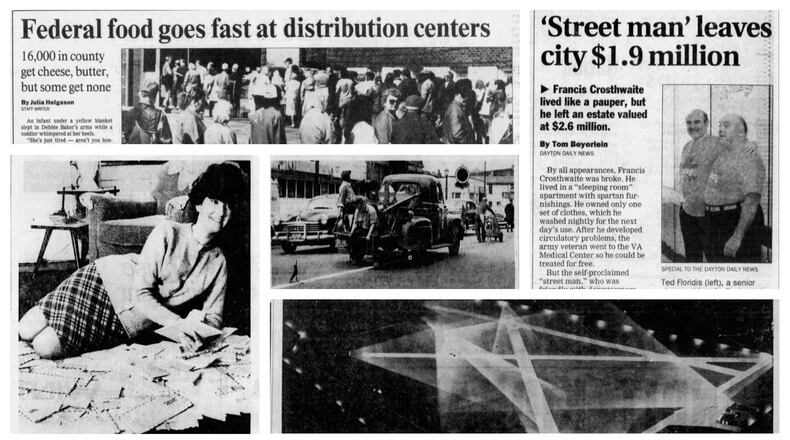Here’s a look at some stories happening the week of April 30-May 6.
May 2, 1937: How Dayton airport will look in nights to come with lights ablaze
An artist’s conception was released showing how the runways would look from the air once the lights were in operation at the Dayton airport.
Night service was just starting at the airport with a the arrival of an eastbound TWA airplane at 6:51 p.m. and its departure 10 minutes later on the day before this article was published.
The extension of this same service and the addition of a westbound night plane would be possible throughout the year with the operation of the lights.
The Dayton air traffic manager said at the time that Dayton was putting on “a splurge in air travel.” Similar gains were being seen all along the transcontinental line. New 21-passenger planes were to be put into service later that summer.
April 30, 1951: City begins marking traffic lanes
Practically all paint on Dayton streets was removed during a severe winter by the salt and cinders used to remove the snow and ice.
About 500 gallons of white paint and 400 gallons of yellow paint were on hand, and several hundred more gallons were on order. The work was expected to take several summer months.
A small hand-pushed machine did the striping. A small pickup truck followed the line striper, and two men would put down red flags to warn motorist of “wet paint.”
Crosswalks, which saw heavy use, had to be painted every six weeks no matter what.
This was the first year that the City Commission ordered paint to be used city-wide instead of using metal markers.
May 6, 1959: 1,200 on move at Chaminade
It was moving day for 1,200 Chaminade high school students. Students and faculty members pitched in to lug desks and equipment out of the old Chaminade building at Ludlow and Franklin streets.
The structure was to be razed to make way for a new $400,000 laboratory and classroom building slated to open the following year.
“Operation Big Move” forced the students at different grade levels to temporarily move to different schools. In a chain reaction, some students at the elementary level were also being displaced.
A new two-story structure was planned that would house five classrooms, science laboratories, lecture rooms, the library, a bookstore, mechanical drawing and typing rooms, a visual aids room and administrative offices.
May 3, 1967: Woman can’t keep up with letters to GIs
Jackie Kiefer, a junior at the University of Dayton, started a project encouraging American servicemen in Vietnam to write, thinking she could find girls to write back to them.
She found about 300 women to write letters, but the letters kept coming by the bushel basket. She was receiving about 30 letters a day and had a backlog of over 600 letters.
Letters started pouring in from all the services and from servicemen of other countries fighting in the Vietnam war.
“I’ve written over 300 and my hand’s tired,” she said. “I have a cousin on the USS Enterprise and he’s always sending me the names of sailors to find girls to write to, so I decided to do it on a larger scale. I didn’t know it would be that large a scale.”
April 30, 1977: Star Trek fans converge on UD Arena
About 3,000 fans converged on the University of Dayton Arena for a galactic happening.
Some wore costumes reminiscent of the characters who had been featured in Star Trek before NBC took it off the air in 1969, and a Star Trek cult was formed.
Gene Roddenberry, the producer, and creator of Star Trek was even present to lead a discussion of Star Trek stories at the event.
Trekkie Mike Arquilla, attired in black tights with sequins slowly raised his phaser gun and fired. “Designed it myself,” he said.
Half her body painted black, the other half white, Linda Stoops of Jefferson Twp. came as a resident of the planet Cheron. “I love this,” she said. “I love Star Trek because it was so believable. Things that happened in it could really happen.”
May 1, 1987: Federal food goes fast at distribution centers
More than 250 people were lined up around Memorial Baptist Church in Dayton where volunteers were distributing federal surplus of cheese and butter. Each of the 2,200 recipients took home five pounds of cheese and one pound of butter.
The church was one of 11 places in Montgomery County were surpluses were being distributed.
The line began forming shortly after 7 a.m. and by 1:30 p.m. more than 2,000 pounds of butter and 12,000 pounds of cheese had been given out. Latecomers were turned away. Supplies were always limited, with area food pantries being served first, next home-bound elderly and then the general public. In all, about 16,000 to 17,000 area residents were served.
April 30, 1999: ‘Street man’ leaves city $1.9 million
By all appearances, Francis Crosthwaite was broke. He lived in a “sleeping room” apartment. He owned only one set of clothes, which he washed nightly for the next day’s use. Crosthwaite lived simply because he felt owning possessions would only complicate his life.
But the self-proclaimed “street man,” who was friendly with downtowners from the homeless to executives, was actually a millionaire. He died in 1998 at 67 with an estate worth $2.6 million, $1.9 million of which he gave to the Dayton Foundation to finance community projects.
Crosthwaite moved to Dayton from Kentucky after his parents died in 1954 and worked as a railroad brakeman until he was injured on the job and retired in the early 1970s.
He invested his money and was inspired to use his money for philanthropic causes after a chance meeting with Virginia Kettering in an elevator in the Kettering tower.
About the Author








